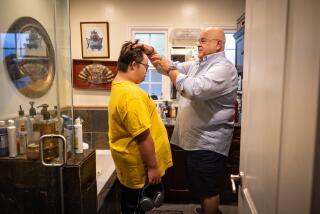State Cuts Could Put Health, Welfare Programs in Jeopardy
- Share via
It was just a fender bender. But the accident last summer propelled Laurence Howard into a red-hot fury, screaming threats at the driver of the other car.
The felony charge that resulted could have landed the Port Hueneme technical writer in jail for six months. Instead, a Ventura County judge ordered Howard, 51, into a program that addressed an underlying factor in his road rage -- untreated mental illness.
For three months, Howard has met weekly with a psychiatrist and social worker to learn to control wild mood swings caused by bipolar disorder.
“I’m getting the help I need. I’m getting the structure,” he said recently at a Ventura clinic run by the county’s Behavioral Health Department. “I would have been angry and possibly suicidal if I had to go to jail.”
Howard may be among the last to benefit from the program, one of several in Ventura County that could be pared back or abandoned because of budget problems in Sacramento.
With the state facing a historic $35-billion shortfall, county budget managers say all bets are off for which programs will survive and which will die. Services in Ventura County could be affected, they say, if $36 million in funding cuts proposed by Gov. Gray Davis are approved.
Child-care subsidies that welfare mothers rely on to hold jobs could be slashed. So could food deliveries and protections for the elderly, mental health programs and other basic health services, as county supervisors look for ways to keep budgets in the black.
Losing child-care vouchers would be a blow to Oxnard student Tanya Vasquez, 24, a single mother who is attending night school at Oxnard College to get her high school diploma.
The county’s welfare-to-work program pays for child care for her two sons. Through agreements with the Ventura County Community College District, tuition fees are also covered.
She seemed hesitant about revealing her long-term goal: to earn a law degree and open her own practice. But Vasquez still savors the day, years ago, that she successfully fought an eviction in San Diego by researching landlord-tenant laws.
“When I go into a law library, it’s like a candy store for me. I like to do research,” she said at the Oxnard Job & Career Center, where she was rewriting a job resume. “I know it’s a long-term goal. But I’m only 24, and I plan to have the career I want by the time I’m 40.”
If she had to do it all without help, it might be tempting to just give up, Vasquez said.
Right now, welfare recipients qualify for two years of subsidized child care as they further their eduction or learn job skills. In the future, they may have to get on a waiting list -- or go without, said Barry Zimmerman, the program’s deputy director.
Another concern is that social worker caseloads could increase if the county is forced to trim its work force. Welfare recipients then no longer would receive the one-on-one attention that has become the hallmark of successful reform efforts around the nation.
Under reforms enacted locally five years ago, single parents, job seekers and others can find help under one roof at Job & Career centers spread across the county.
Zimmerman said he fears a return to the time when the welfare department focused on handing out checks instead of preparing recipients for jobs.
“We don’t want to shift from delivery of services to administration of aid. That is kind of defeating the whole welfare reform push,” he said.
Ramona Gomez has one word for the county’s Job & Career centers: “Awesome.”
Gomez, 24, dressed in conservative work attire, performs clerical duties 16 hours a week at the Oxnard center. Besides on-the-job-training, she receives counseling to sort out a history of domestic abuse and money to help secure child care for her 19-month-old daughter.
Gomez acknowledges the mistakes of her past. She began having babies at 16 and her first two children were adopted out. Now nine months pregnant, she plans to return to work six months after the birth of her next child.
Gomez said she has matured and, with the help of social workers, has come to realize that a life on welfare holds little future for her children or herself.
“This is the best thing they’ve done,” she said, as she archived files on a Microsoft program. “They’re not just giving you money and that’s it. They are trying to help us with our problems so we can get out there and work.”
Services for seniors may also be targeted. The county’s Area Agency on Aging has been told that the $23,000 in state funding it receives each year to run a grocery program for home-bound seniors probably will be eliminated.
The program provides a bag of groceries to 2,000 seniors across the county each week, said Karen Kaminsky, a program director at Little House, an Ojai senior center.
Volunteers also use the weekly delivery to check in on folks, Kaminsky said. Cutting back would mean not only less food, but also less supervision of isolated seniors, she said.
“For very little money, we are helping a heck of a lot of people,” Kaminsky said.
The state is also considering the elimination of a hotline to report elder abuse, Zimmerman said.
Funding for special mental health programs has already been cut by Sacramento, but Ventura County has enough money to keep those programs afloat through the end of the year.
One of them is the jail diversion program that Laurence Howard entered. Others help adults with major psychiatric disorders, such as schizophrenia, and find housing, counseling and other community resources to avoid being institutionalized.
In Howard’s case, the judge agreed that it made more sense to treat his mental illness than to throw him in jail, said Gayle Schrum, the program’s manager.
The program is only available to low-level offenders. Howard qualified when his felony charge of making terrorist threats was reduced to a misdemeanor, Schrum said.
She is worried about the effect in communities if less help is available.
“It’s amazing how many people are walking around with severe impairments,” she said. “A lot of them go live in the river bottom. If we lose this funding, we lose the ability to serve someone who doesn’t have anyone else to turn to.”
Howard believes his case was a turning point.
He has finally found the right medication to control his bipolar disorder. For the first time in years, Howard is feeling positive about his future and is thinking of finding work teaching tai chi -- a longtime passion.
“This [his rehabilitation] forced me into seeing the seriousness of my illness,” he said. “It’d be a shame if it went away.”
More to Read
Sign up for Essential California
The most important California stories and recommendations in your inbox every morning.
You may occasionally receive promotional content from the Los Angeles Times.











